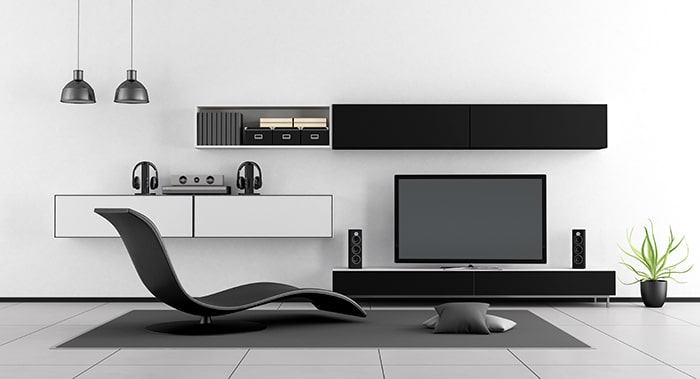Next-Generation Speaker Design

Image Source: viperagp - stock.adobe.com
By Tony Ives for Mouser Electronics
Loudspeakers have been the default way of reproducing audio signals since the early 1920s. Over time, they have evolved technically and, with the advent of high-quality music streaming and smart speakers, are increasing in number. For faithful high quality music reproduction, the next generation of speakers are incorporating a number of advanced design features. In this article, we investigate some of the techniques employed to improve the fidelity of audio reproduction.
High-end Active Designs
Many modern speakers are active units. In these designs, the audio signal is split into two frequency bands at the input, by "active" or "crossover" electronic filters. The advantage of dividing the signal at this point as opposed to using a "passive" unpowered crossover, fed from the amplifier signal at the speaker end, is one of efficiency. Passive crossovers use high-voltage and inefficient wound components that sap much of the energy from the amplifier. Meanwhile, an active crossover filter can be designed with more accuracy and fewer losses. There is independent control over the output signal level—affording simple matching of the crossover to individual drive unit sensitivities. The active filter’s performance is unaffected by changes in impedance of the drive unit. These changes can be the result of increased temperature in the drive unit’s voice coil, which in the case of a passive crossover, may alter the crossover point and potentially introduce distortion. The two discrete frequency bands—the output from the crossovers—are then fed into two separate amplifiers: One for the high-frequency driver (tweeter) and one for the mid-/low-frequency driver (woofer). By using two separate amplifiers in this way, they both operate over a limited bandwidth, which reduces intermodulation distortion. The use of super-efficient class D power amplifiers, with inbuilt digital signal processing (DSP), is commonplace. The DSP is used to optimize the output and protect the drivers. These active designs utilize the proliferation of high quality audio amplifier integrated circuits (ICs), DSPs, and system-on-chips (SoCs) available today. The various features, conversion, processing, and communication can be positioned in either the digital or analog domain to optimize the sonic quality of the design. Wireless connectivity allows access to high quality streaming services and connecting units together for the multi-room experience (Figure 1).

Figure 1: Various different units connecting together come together for a unique room experience. (Source: archideaphoto/shutterstock.com)
Amplifier Innovations
Class D amplification offers highly efficient audio amplification with a low quiescent (standby) current. The amplifying devices (transistors) operate as switches, switching fully on or fully off depending on the incoming signal. These transistors, traditionally metal–oxide–semiconductor field-effect transistors (MOSFETs), have a fast on/off time (slew rate) and a low on-resistance, with this being important for amplifier efficiency. The audio input and a precisely generated triangular waveform are input to a comparator, the output (a train of pulses) of which feeds the transistors. The transistors then turn alternately "hard" on and off between the two power rails, and thus an output pulse waveform is generated; the pulse width is proportional to the input’s instantaneous signal level. Finally, this output is fed through a low-pass filter, allowing the original input signal to be reconstructed.
Traditionally, due to the high frequencies being generated internally (RF interference), the poor damping factor, and the amplifier’s ability to control the excursion of the speaker cone, this class of amplifier has mainly been featured in designs where weight, efficiency, and small size are important. Examples are car audio, live sound, and portable systems. However, recent innovations enabled this amplifier class to more closely rival its linear counterpart. Developments in transistor technology, such as gallium nitride (GaN), can yield very impressive total harmonic distortion (THD) figures, which compare favorably with more traditional linear designs. Other innovations, such as the direct digital feedback amplifier technology, based on a unique closed-loop digital architecture and using high-resolution digital signal processing to maintain audio performance consistency, have enhanced this class of amplifier further. In the case of an active speaker, this technology can be integrated into the design and matched to the driver’s impedance and response. This provides consistent sound quality at all levels and protects the drive units from damage.
Digital Room Compensation (DRC)
Due to their different shapes and the variety of materials used within them—soft furnishings, pipe boxes, etc.—the reflective properties of listening rooms are not equal to all frequencies (Figure 2). Depending on their frequency, the waveforms reflect, collide, and are absorbed in a chaotic manner. This causes areas of constructive and destructive interference. Nodes, areas where certain frequencies are boosted, and antinodes, areas where certain frequencies are attenuated, are set up throughout the room. The speaker positioning in relation to the room boundaries can have a huge impact on this, as can the listening position. Obviously, from the point of view of sonic clarity, this is not ideal. The amount these signals are affected can be significant enough to "color" the perceived musical content, and this effect is known as "comb filtering."

Figure 2: Soft furnishings on the wall affect the reflective properties of sound within a recording studio. (Source: Stock image/shutterstock.com)
Recording studios have always used a combination of sound treatment and room compensation in their control rooms to minimize the room’s effect on the perceived sound. However, DRC systems aim to optimize the speaker's response to a given room, usually in three steps. First, the system measures the room’s response to a range of frequencies, and an audio signal containing a random spread of frequencies is reproduced through the speakers (pink noise). A reference microphone is set up in the listening position and an analysis of the room’s response to these frequencies is made (spectral analysis). This data is used to generate filters, which then boost or attenuate these "trouble" frequencies to effectively "flatten" the room’s response. The filter is then set and applied to the audio program. Many modern speakers incorporate a digital signal processing element in their design, which enables this option to be part of their feature set. Standalone DRC units, with reference microphones, are also available. This technique is becoming a more regular feature in next-generation devices.
Cabinet Design
The cabinet is, perhaps surprisingly, the biggest cost element in loudspeaker design. A well-designed and constructed cabinet must support the driver units firmly and not respond to the vibrations of the drivers themselves. The front face of the cabinet, on which the driver units are mounted, is called a baffle. The material used here is often a little thicker than the material used in the rest of the cabinet. The idea is to keep everything as rigid as possible, so the cabinet is not "heard." Bracing is often used, particularly in the area of the bass units. This is important, as it raises the resonant frequency of the cabinet in these areas and lowers the risk of sympathetic vibration. Chambers for the different drive units are often constructed. The sound that comes from the rear of the bass driver is out of phase and thus, if mixed, would subtract (attenuate) the signal coming from the front of the speaker. In some designs, this rear voice is phase-shifted, ducted, and added to the signal emanating from the front of the speaker by means of a port or letterbox opening. Some high-end units feature inverted horn shapes, behind the drivers, to dampen (attenuate) these unwanted elements from the listener. Extension tubes, mounted on the baffle, are often employed. Their lengths are carefully calculated to allow resonance in the chamber at low frequencies, raising the bass efficiency of the speaker. In this way, a smaller design can produce a bass response that belies its size. Obviously, in the case of an active design with integral signal processing, the response of the drive units can be optimized for a given design. It has to be said that the design of a successful high-end cabinet is the result of considerable time and effort (and research), the cost of which can run to many thousands of dollars.
Drive Units
The most common drive unit encountered as a transducer for mid/low frequencies is a dynamic loudspeaker (Figure 3). This utilizes a permanent magnet (often neodymium), a voice coil, a frame or basket, and a speaker cone. The electrical energy derived from the amplifier is converted by the interaction of the voice coil and the magnet into motion (excursion) of the cone. This causes compression (forward-moving cone) and rarefaction (backward-moving cone) of the air mass in contact with the cone, proportionally to the incoming signal, and in this way, sound waves are produced. There are a number of compromises made here. The cone must be very light, so as to not present inertia (resistance to movement), and also it needs to be rigid (any distortion across the surface of the cone will result in coloration of the audio produced). Historically, a wide variety of cone materials have been used, such as treated paper (very light), aluminum (rigid), and ceramic materials. Recently, aerospace materials have been employed, often with a golf-ball texture to allow the air to pass over them more smoothly. Additionally, the voice coil represents an inductive load. It will present different impedances to the amplifier at differing frequencies, posing design considerations for the amplifier.

Figure 3: The most common drive unit is a transducer. (Source: Alpha_7D/shutterstock.com)
High-frequency transducers (tweeters) can fall into two main types. The dynamic variety, constructed in a similar manner to its low/mid counterpart, but using different materials in its construction, is optimized for its high-frequency response. Manufacturers can sometimes use synthetic diamonds for their dome material. This is extremely rigid and also light, so it does not warp and can push air around efficiently. These synthetic diamonds are grown in ovens at 1500°C, and are expensive to produce.
Other tweeter variants include ribbon types. These feature an ultra-thin metal diaphragm (the ribbon) suspended in an electromagnetic field. Because this diaphragm is so light, it is able to respond to even the tiniest subtlety and so yields a very detailed picture of the incoming high frequency audio. The disadvantage of this type is its very low impedance, which means it may need a transformer to match it to the amplifier. They are expensive and also delicate. Another type of speaker that deserves a mention here is the electrostatic design. This uses an ultra-thin, flat diaphragm, sandwiched between two electrically conductive grids. One diaphragm is used to reproduce all frequencies, as it is thin enough to respond to high frequencies and the surface area is large enough for it to reproduce bass frequencies. They do this with extreme fidelity (lack of distortion) and, providing they are positioned carefully in the room, the sound they produce will be less affected by the layout of the room. Because electrostatic units do not have an enclosure as such, they can be architected to coordinate with the room design. They are much more delicate than their magnetic-based counterparts, are prone to damage through overload, and so are less popular in modern designs.
Conclusion
With the proliferation of high-quality audio ICs, DSPs, and SoCs, active designs, with inbuilt streaming and multi-room capabilities, are becoming more commonplace within the domestic audio sphere. Digital room compensation and innovative driver control can help a small speaker achieve a really big sound, and a standard bookshelf one to sound incredible. The active architecture gives the designer control over important parameters, such as drive unit choice, protection, and the placement of features within the digital/analog domain, allowing for circuit optimization in these areas, with the added aesthetic benefit of reduced cabling.